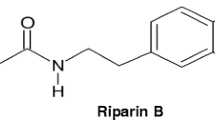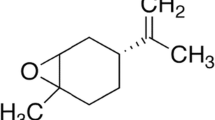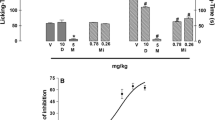Abstract
Cyane-carvone (CC) was studied to elucidate its anti-inflammatory, antinociceptive, and antioxidant effects in Mus musculus. Anti-inflammatory (bradykinin, histamine, prostaglandin E2, serotonin, and carrageenan) and antinociceptive (acetic acid and formalin) models were utilized. Myeloperoxidase activity, interleukin (IL)-1β, tumor necrosis factor alpha (TNF-α), and glutathione (GSH) levels were evaluated. Analysis of variance followed by Student-Newman-Keuls’ test was done. Results were compared with control groups (significantly when p < 0.05). In bradykinin, histamine, prostaglandin E2, and serotonin tests, 75 mg/kg CC decreased significantly paw edema (t = 30, 60, 90, and/or 120 min). In carrageenan test, 50 and 75 mg/kg CC (t = 3 h and t = 4 h) and 25 mg/kg CC (t = 4 h) decreased significantly paw edema. CC (75 mg/kg) inhibited significantly mieloperoxidase activity and decreased IL-1β and TNF-α, and all doses increased GSH levels. CC (75 mg/kg) decreased significantly the number of contortions of animals and time of licking (phase 2). CC showed anti-inflammatory, antinociceptive, and antioxidant effects in mice.






Similar content being viewed by others
References
Vodovotz, Y., G. Constantine, J. Rubin, et al. 2009. Mechanistic simulations of inflammation: Current state and future prospects. Mathematical Biosciences 17: 1–10.
Cuzzocrea, S., G. Costantino, B. Zingarelli, et al. 1999. The protective role of endogenous glutathione in carrageenan-induced pleurisy in the rat. European Journal of Pharmacology 372: 187–197.
Loria, V., I. Dato, F. Graziani, et al. 2008. Myeloperoxidase: A new biomarker of inflammation in ischemic heart disease and acute coronary syndromes. Mediators of Inflammation 2008: 1–4
Harrison, P., J.J. Pointon, K. Chapman, et al. 2008. Interleukin-1 promoter region polymorphism role in rheumatoid arthritis: A meta-analysis of IL-1B-511A/G variant reveals association with rheumatoid arthritis. Rheumatology 47(12): 1768–1770.
Borsook, D. 2011. Neurological diseases and pain. Brain 135(2): 320–344.
Gonçalves, J.C., A.M. Alves, A.E. de Araújo, et al. 2010. Distinct effects of carvone analogues on the isolated nerve of rats. European Journal of Pharmacology 645(1–3): 108–112.
Helander, I.M., H. Alakomi, K. Latva-Kala, et al. 1998. Characterization of the action of selected essential oil components on Gram-negative bacteria. Journal of Agricultural and Food Chemistry 46(9): 3590–3595.
Smid, E.J., J.P.G. Koeken, and L.G.M. Gorris. 1996. Fungicidal and fungistatic action of the secondary plant metabolites cinnamaldehyde and carvone. In Modern fungicides and antimicrobial compounds, ed. H. Lyr, P.E. Russell, and H.D. Sisler, 173–180. Andover: Intercept.
Costa, D.A., G.A. Oliveira, T.C. Lima, et al. 2012. Anticonvulsant and antioxidant effects of cyano-carvone and its action on acetylcholinesterase activity in mice hippocampus. Cellular and Molecular Neurobiology 32(4): 633–640.
Costa, D.A., G.A.L. Oliveira, J.P. Costa, et al. 2012. Avaliação da toxicidade aguda e do efeito ansiolítico de um derivado sintético da carvona. Revista Brasileira de Ciências da Saúde 16(3): 303–310.
Cocker, W., D.H. Grayson, and P.V.R. Shannon. 1995. Hydrocyanation of some α,β-unsaturated ketones, and the synthesis of some unusual isoxazoles. Journal of the Chemical Society, Perkin Transactions 1(9): 1153–1162.
Costa, D.A., G.A.L. de Oliveira, D.P. de Sousa, et al. 2012. Avaliação do potencial antioxidante in vitro do composto ciano-carvona. Revista de Ciências Farmacêuticas Básica e Aplicada 33(4): 567–575.
Institute of Laboratory Animal Resources. 1985. Guide for the care and use of laboratory animals, 6th ed. Washington, DC: National Academy Press.
Hargreaves, K., R. Dubner, F. Brown, et al. 1988. A new and sensitive method for measuring thermal nociception in cutaneous hyperalgesia. Pain 32: 77–88.
Winter, C.A., E.A. Risley, and C.W. Nuss. 1962. Carrageenan-induced oedema in hind paw of the rat as an assay for anti-inflammatory drugs. Proceedings of The Society for Experimental Biology and Medicine 111: 544–547.
Kasahara, Y., H. Hikino, S. Tsurufiji, et al. 1985. Antiinflammatory actions of ephedrines in acute inflammations. Planta Medica 51: 325–331.
Cole, H.W., C.E. Brown, D.E. Magee, et al. 1995. Serotonin-induced paw edema in the rat: Pharmacological profile. General Pharmacology 26(2): 431–436.
Yesilada, E., and E. Küpeli. 2002. Berberis crategina DC. Root exhibits potent anti-inflammatory, analgesic and febrifuge effects in mice and rats. Journal of Ethnopharmacology 79: 237–248.
Bradley, P.P., D.A. Priebat, R.D. Christensen, et al. 1982. Measurement of cutaneous inflammation: Estimation of neutrophil content with an enzyme marker. Journal of Investigative Dermatology 78: 206–209.
Silva, R.O., Sousa, F.B.M. , Damasceno S.R.B. et al. 2013. Phytol, a diterpene alcohol, inhibits the inflammatory response by reducing cytokine production and oxidative stress. Fundamental & Clinical Pharmacology 1-27
Cunha, F.Q., M.A. Boukili, J.I.B. Motta, et al. 1993. Blockade by fenspiride of endotoxin-induced neutrophil migration in the rat. European Journal of Pharmacology 238: 47–52.
Sedlak, J., and R.H. Lindsay. 1968. Estimation of total, protein-bound, and nonprotein sulfhydryl groups in tissue with Ellman’s reagent. Analytical Biochemistry 24: 1992–2005.
Koster, R., M. Anderson, and E.J. De Beer. 1959. Acetic acid for analgesic screening. Federation Proceedings 18: 412–416.
Hunskaar, S., and K. Hole. 1987. The formalin test in mice dissociation between inflammatory and non-inflammatory pain. Pain 30: 103–114.
Dash, S., S.K. Kanungo, and S.C. Dinda. 2013. Anti-inflammatory activity of Aponogeton natans (Linn.) Engl. & Krause in different experimental animal models. Der Pharmacia Lettre 5(1): 136–140.
Campos, M.M., and J.B. Calixto. 1995. Involvement of B1 and B2 receptors in bradykinin-induced rat paw oedema. British Journal of Pharmacology 114: 1005–1013.
Posadas, I., M. Bucci, F. Roviezzo, et al. 2004. Carageenan-induced mouse paw oedema is biphasic, age-weight dependent and displays differential nitric oxide cyclooxygenase-2 expression. British Journal of Pharmacology 142: 331–338.
Samad, T.A., A. Sapirstein, and C.J. Woolf. 2002. Prostanoids and pain: Unraveling mechanisms and revealing therapeutic targets. Trends in Molecular Medicine 8(8): 390–396.
Linardi, A., S.K.P. Costa, G.R. Da Silva, et al. 2002. Involvement of kinins, mast cells and sensory neurons in the plasma exudation and paw edema induced by staphylococcal enterotoxin B in the mouse. European Journal of Pharmacology 399: 235–242.
Cuman, R.K.N., C.A. Bersani-Amadio, and Z.B. Fortes. 2001. Influence of type 2 diabetes on the inflammatory response in rat. Inflammation Research 50: 460–465.
Skidmor, I., and M. Whitehouse. 1967. Biochemical properties of anti-inflammatory drugs X: The inhibition of serotonin formation in vitro and inhibition of the esterase activity of α-chymyotrysin. Biochemical Pharmacology 16: 737–751.
Di Rosa, M., J.P. Giroud, and D.A. Willoughby. 1971. Studies on the mediators of the acute inflammatory response induced in rats in different sites by carrageenan and turpentine. The Journal of Pathology 104: 15–29.
Di Rosa, M., J.M. Papadimitriou, and D.A. Willoughby. 1971. A histopathological and pharmacological analysis of the mode of action of nonsteroidal anti-inflammatory drugs. The Journal of Pathology 105: 239–256.
Di Rosa, M. 1972. Biological properties of carrageenan. Journal of Pharmacy and Pharmacology 24: 89–102.
Garcia Leme, J., L. Hamamura, M.P. Leite, et al. 1973. Pharmacological analysis of the acute inflammatory process induced in the rat’s paw by local injection of carrageenin and by heating. British Journal of Pharmacology 48: 88–96.
Nantel, F., D. Denis, R. Gordon, et al. 1999. Distribution and regulation of cyclooxygenase-2 in carrageenan-induced inflammation. British Journal of Pharmacology 128: 853–859.
Henriques, M.G.M.O., P.M.R. Silva, M.A. Martins, et al. 1987. Mouse paw oedema. A new model for inflammation. Brazilian Journal Of Medical and Biological Research 20: 243–249.
Morris, C.J. 2003. Carrageenan-induced paw edema in the rat and mouse. Methods in Molecular Biology 225: 115–121.
Salvemini, D., Z.Q. Wang, and P.S. Wyatt. 1996. Wyatt et al. Nitric oxide: A key mediator in the early and late phase of carrageenan-induced rat paw inflammation. British Journal of Pharmacology 118: 829–838.
Banani, A., N. Maleki-Dizaji, H. Niknahad, et al. 2012. N-Acetylaspartylglutamate (NAAG) exhibits anti-inflammatory effects on carrageenan-induced paw edema model of inflammation in rats. African Journal of Pharmacy and Pharmacology 6(23): 1702–1709.
Gabay, C., C. Lamacchia, and G. Palmer. 2010. IL-1 pathways in inflammation and human diseases. Nature Reviews. Rheumatology 6(4): 232–241.
Esposito, E., and S. Cuzzocrea. 2009. TNF-alpha as a therapeutic target in inflammatory diseases, ischemia-reperfusion injury and trauma. Current Medicinal Chemistry 16(24): 3152–3167.
Liao, J.C., J.S. Deng, C.S. Chiu, et al. 2012. Anti-inflammatory activities of Cinnamomum cassia constituents in vitro and in vivo. Evidence-Based Complementary and Alternative Medicine 2012: 1–12.
Cuzzocrea, S. 2005. Shock, inflammation and PARP. Pharmacological Research 52: 72–82.
Negus, S.S., T.W. Bandera, M.R. Brandt, et al. 2006. Preclinical assessment of candidate analgesic drugs: Recent advances and future challenges. Journal of Pharmacology and Experimental Therapeutics 19: 507–514.
Zeilhofer, H.U. 2005. Synaptic modulation in pain pathways. Reviews of Physiology, Biochemistry and Pharmacology 154: 73–100.
Mazur, A., and S. Fidecka. 2011. The antinociceptive effects of topiramate evaluated in writhing test in mice. Current Issues in Pharmacy and Medical Sciences 24(1): 111–120.
Puig, S., and L.S. Sorkin. 1996. Formalin-evoked activity in identified primary afferent fibers: Systemic lidocaine suppresses phase-2 activity. Pain 64: 345–355.
Han, Y.K., S.H. Lee, H.J. Jeong, et al. 2012. Analgesic effects of intrathecal curcumin in the rat formalin test. The Korean Journal of Pain 25(1): 1–6.
Acknowledgments
This work was funded by the National Council for Scientific and Technological Development (CNPq) and Research Supporting Foundation of State of Piauí (FAPEPI/Brazil).
Author information
Authors and Affiliations
Corresponding author
Rights and permissions
About this article
Cite this article
Marques, T.H.C., Marques, M.L.B.G.C.B., Medeiros, JV.R. et al. Cyane-carvone, a Synthetic Derivative of Carvone, Inhibits Inflammatory Response by Reducing Cytokine Production and Oxidative Stress and Shows Antinociceptive Effect in Mice. Inflammation 37, 966–977 (2014). https://doi.org/10.1007/s10753-014-9817-1
Published:
Issue Date:
DOI: https://doi.org/10.1007/s10753-014-9817-1




